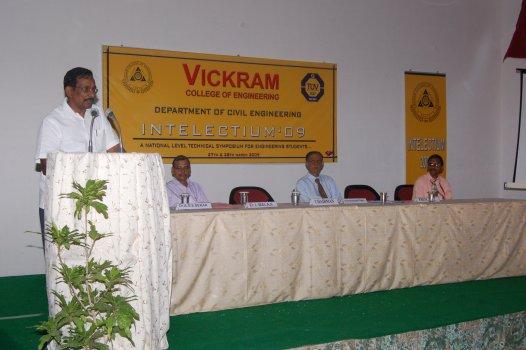- Written by Ponraj sankar
- Hits: 2026
INTELECTIUM ’10 – EVENTS REPORT OF CIVIL ENGINEERING
EVENT I PAPER PRESENTATION
WINNERS
FIRST PRIZE
V
Title : GIS as a Decision Support System in Emergency Recovery Planning
Abstract
Optimum utilization of the time after an accident which is golden hour serves as a measure of effectiveness of any emergency response service provider system. Recovery actions should be taken in time to reduce the loss of life and property. In spite of the reason that the service providers are well equipped, routing problems and traffic congestions breaks their speedy recovery action in real time. This paper presents a case study on
SECOND PRIZE
S. DINESH & MEERAN
JJ
Title : REPAIR AND REHABILITATION OF RC STRUCTURES
(Failure mode of GFRP confined concrete)
Abstract
A large stock of existing structure starts deteriorating due to excess load or design period or adverse environmental effects and need retrofitting and repair. This focuses on latest advances in materials, techniques and the current state of the art of rehabilitation of concrete structure. This process covers understanding the root cause of distress in reinforced concretes, structural diagnosis and assessment method including their usefulness and limitations.
1. N.MOHANRAJ and Denny Dominic
Title : Experimental Studies On Reducing Thickness Of Flexible Pavements By Using Woven And Non-Woven Geo-synthetics In Subsurface.
Abstract
Pavement or Road surface is the durable surface material laid down on an area intended to sustain traffic (vehicular or foot traffic), such surfaces are frequently marked to guide traffic. The most common modern paving methods are asphalt and concrete. in the past, brick was extensively used, as was metalling. Today, permeable paving methods are beginning to be used more for low-impact roadways and walkways. Bountiful research works have been done in the area of designing of pavements by many methods, the value arrived finally will be the thickness of various layers of payment. If there arise a need to reduce the thickness of pavement it is mandatory to introduce some reinforcing material should be introduced in the pavement to increase its strength. Many materials, fibres, composites were tried as reinforcing material for both flexible and rigid pavements and several researches being done to identify newer cost effective and better material. Geosynthetics proved to be a great choice of such a material and it was applied in many projects successfully. Various types of Geosynthetics were tried in the pavements and found to be exultant in reducing the thickness of the pavements which leads to considerable cost savings. This paper describes various methods of flexible pavement design and also describes the way the Geosynthetics can be used to reduce pavement thickness. A detailed case study was proved to give clear picture about how the thickness of the pavement reduces when Geosynthetics are used in the soil. Geosynthetics both woven and Non-woven can be tried with various types of soils depending on the soil stability and other parameters but it was widely practiced using of Geonets and Geogrids for reinforcing the soil which also found to be satisfactory in reducing pavement thickness.
2. R.RAJARAJACHOLAN and P DIWAHAR
REPAIR AND REHABILITATION OF RCC STRUCTURES USING FRP
Abstract
Recent earthquakes and other natural disasters have illustrated the vulnerability of existing reinforced concrete structures (RCC beams, columns, beam – column joints); to seismic loading. Since effective and economical rehabilitation techniques in existing structures are needed. The objective of this paper is to develop the effective selective rehabilitation schemes for reinforced concrete structures using advance composite materials (FRP – Fibre Reinforced Polymer). From the study conducted, it is found that the use of FRP composites leads to, increase in the shear capacity and ductility. Energy dissipation capacity also can be increased with the use of small amount of composites.
3. SHANMUGA VIGNESH.V AND KARTHICK RAJA.P
Title: Experimental Studies On Viability Of Using Geosynthetics As Fibers In Concrete
Abstract:
It is evident from literature review that in the recent decades the thrust for finding an alternative to the costly steel reinforcement is increasing, several alternatives have been tested across the globe. Some viable alternatives are found, also many techniques of replacing the steel and addition of tensile strength to concrete is studied. The methods which are found to be cost effective and feasible are also tried in construction in various areas. Once such alternative technique is providing subsidiary reinforcement in the way of addition of natural or artificial fibers to the concrete. Several fibers are also tried with concrete, some proved to be successful in adding strength and durability to the concrete but still now many fibers are in research stage only. Copious materials were introduced as additional fibers to concrete such as polypropylene, glass fibers, FRP, coir etc. This paper describes an attempt made to incorporate geosynthetics, a material is used reinforced soil as fibers in concrete. Geosynthetics are used widely aa soil reinforcement, separators, drainage, filters and also used across the globe in various infrastructure projects. In spite of several studies being done in Geosynthetics with soil, Geosynthetics fiber had never been added with concrete. This paper details the attempt made to check the viability of using geosynthetics as fibers in concrete.
EVENT II TECHNICAL QUIZ
WINNERS
I PRIZE: SHANMUGA VIGNESH.V AND KARTHICK RAJA.P,
II PRIZE: P DIWAHAR & P HARISH JEGAN,
EVENT III CODE CRACKING
WINNERS
I PRIZE: R.RAJARAJACHOLAN and K A KARTHICK RAJAN
II PRIZE:
JJ
EVENT IV CADD CONTEST
WINNERS
I PRIZE: P HARISH JEGAN,
II PRIZE:
Congratulations to the winners!!!

